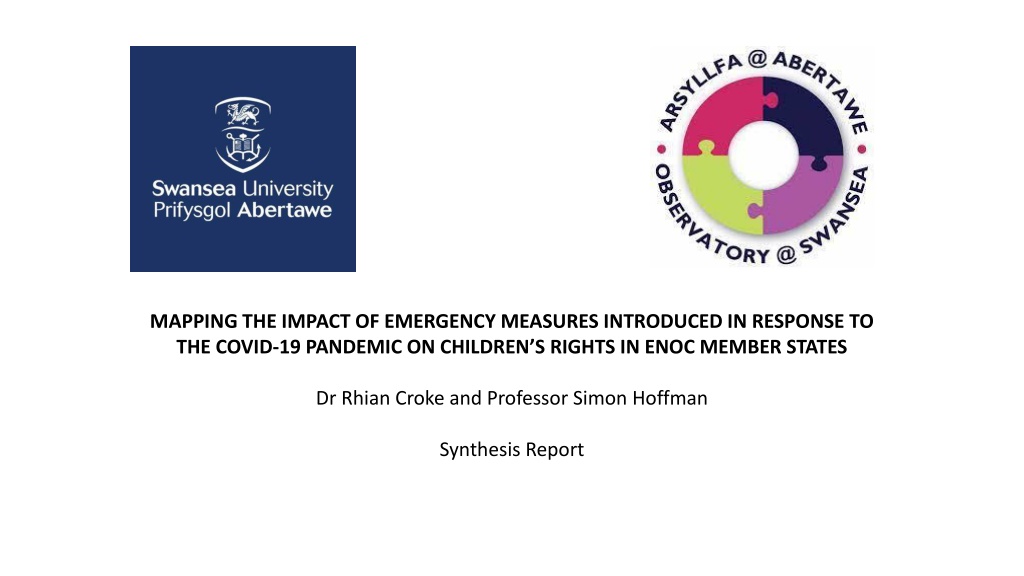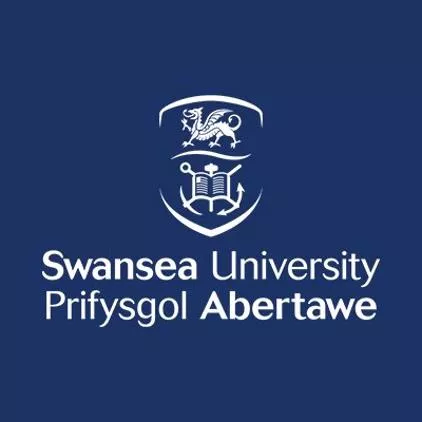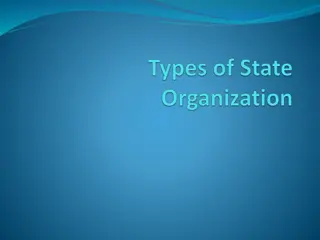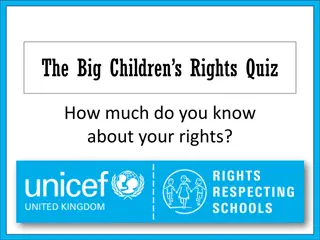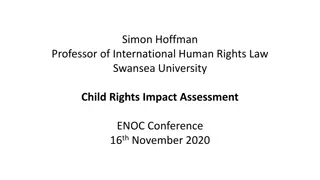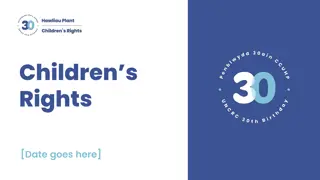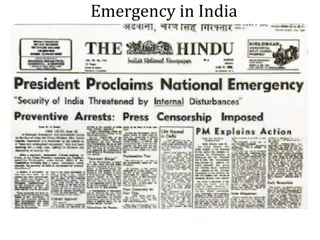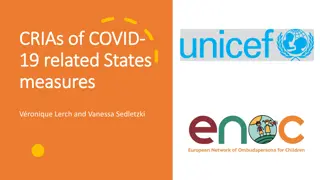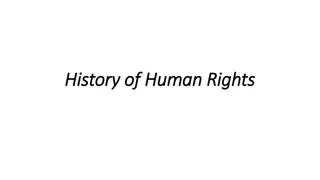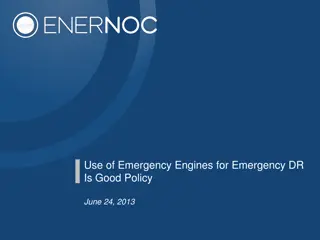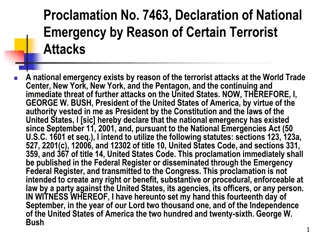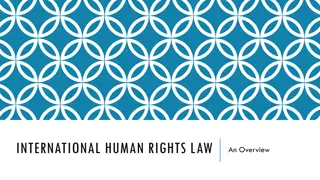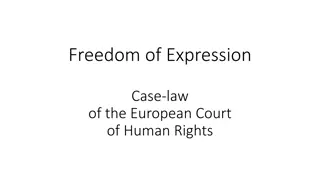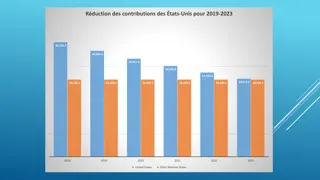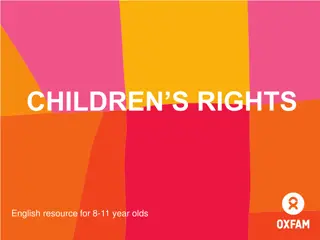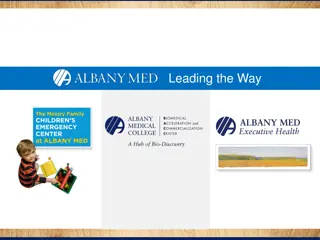Impact of Emergency Measures on Children's Rights in ENOC Member States
Overview of a research report commissioned by ENOC to map the impact of Covid-19 emergency measures on children's rights across ENOC member states. Findings show negative impacts on national planning, coordination, and attention to children's rights, with some governments taking steps to minimize adverse effects. Reflections from ENOC members highlight delays in legislative and administrative processes, lack of child specialist involvement, and insufficient consideration of children's impact in decision-making during emergencies.
Download Presentation

Please find below an Image/Link to download the presentation.
The content on the website is provided AS IS for your information and personal use only. It may not be sold, licensed, or shared on other websites without obtaining consent from the author. Download presentation by click this link. If you encounter any issues during the download, it is possible that the publisher has removed the file from their server.
E N D
Presentation Transcript
MAPPING THE IMPACT OF EMERGENCY MEASURES INTRODUCED IN RESPONSE TO THE COVID-19 PANDEMIC ON CHILDREN S RIGHTS IN ENOC MEMBER STATES Dr Rhian Croke and Professor Simon Hoffman Synthesis Report
THE RESEARCH ENOC commissioned research to: Map impact of Covid-19 Emergency Measures on children s rights across ENOC member states METHODOLOGY On-line survey Based on the UN Committee s thematic reporting guidelines Provides recognisable structure Ensures points of contact with identified areas of State responsibility Aligns with State party reporting Discrete section on Child Rights Impact Assessment (CRIA), or other advance analysis of impact of Emergency Measures Links to Position Statement 2020 Identified by Committee as key step to ensure proper consideration of children s rights 32 (74%) ENOC members completed the survey excellent response rate! NB: findings reflect perceptions of ENOC members well placed to assess impact Key Findings - not <50% of respondents reporting an issue
Key Findings Thematic Area: General Measures of Implementation Emergency Measures have had a negative impact on the General Measures of Implementation National planning and coordination of implementation of children s rights adversely affected General lack of attention to children s rights as a guide to decision-making on Emergency Measures Children or child specialist advisers largely been excluded from decisions about Emergency Measures Children already seen as vulnerable more likely to be severely or disproportionately discriminated Some governments have taken effective steps to minimise negative impact of Emergency Measures (identified for all thematic areas - report details)
ENOC Member Reflections General Measures of Implementation Legislative and administrative processes were stopped during the first stages of the pandemic and in any event, they were affected by delays, as political attention was turned towards the pandemic. (Basque Country) Several pieces of Welsh Government policy work have been delayed or in some cases the pandemic has been used as reasoning for abandoning important policy decisions which impact upon children's rights altogether. (Wales) The team of health experts composed to consult the Council of Ministers undertaking all decisions related to the measures, did not include any professional with expertise on children. (Cyprus) Relating to the general measures of implementation, the most problematic aspect of the emergency measures was that the impact on children was not always taken into account. (Netherlands) Why weren t children s rights taken into account in the development of Emergency Measures? Why were governments able to de-prioritise children s rights so quickly when the pandemic struck?
Key Findings Thematic area: General Principles Emergency Measures have had a negative impact on the General Principles of the Convention. Many groups of children disproportionately affected, in particular: children with additional learning needs; disabled children; children with mental illness; children with mental health problems; children in care; asylum seekers/refugees; children of divorced/separated parents, children in juvenile justice system Children not treated as a specific audience for purposes of consultation/ dissemination of information Children treated as objects of Emergency Measures rather than as participants in their making Pandemic highlighted inequalities between groups of children General Principles not prioritised in development of Emergency Measures - improved as pandemic unfolded
ENOC Member Reflections General Principles Emergency Measures have had disproportionate effects on different groups of children. The State should have prioritised actively identifying individual groups of children that were particularly vulnerable and taken measures to ensure that they were not disproportionately affected and discriminated against . (Iceland) Children were mostly treated as objects of the emergency measures rather than as participants in their making. (Bulgaria) Decision-makers should have engaged with children and considered their views throughout the decision-making process, yet children s views were at times completely absent from decision-making. (Scotland) Little attention to the best interests of children when closing schools (instead of shopping centres etc). (Estonia) How has decision-making on Emergency Measures been affected by systemic discrimination against children? What mechanisms can help overcome discrimination against children when Emergency Measures are developed?
Key Findings Thematic area: Civil Rights and Freedoms Emergency Measures have had a negative impact on children s civil rights and freedoms, in particular freedom of association/assembly, and right to privacy and protection of image Disproportionate negative impact on children with additional learning needs and disabled children Some institutions have restricted children s movements - a risk to children s mental health A digital divide means some children were unable to access the online space For some children move to online assembly offered more opportunities to exercise the right to assembly Concern at lack of regulations to safeguard children s privacy and information rights online
ENOC Member Reflections Civil Rights and Freedoms Legislation was brought in to stop gatherings outdoors and this applied to children. Children were arrested and detained for failing to isolate and breaching the regulations. (Jersey) Some care places wished to restrict children's movement more than prescribed by emergency measures or by using unacceptable means (e.g. to 'lock down' the care place premises). (Estonia) Covid-19 has amplified the lack of measures to safeguard children s rights online. (Iceland) To what extent were restrictions placed on children s civil rights and freedoms necessary, and proportionate? Was the decision on how freedoms were limited based on robust evidence?
Key Findings Thematic Area: Violence Against Children Emergency Measures have had a negative impact on violence against children Significant concern that children at increased risk of domestic abuse, online abuse, general abuse/neglect, sexual exploitation Disabled children, children with additional learning needs and children in care are seen as being at greatest risk of abuse Evidence suggests girls at greater risk of increased violence or abuse Data on violence against children is often inadequate Many governments struggled to maintain services to protect children who may be at significant risk of harm Increased time spent at home/away from school - means children exposed to increased levels of violence Children s use of internet during home confinement means children exposed to increased risk of cyberbullying or online sexual abuse/exploitation Telephone helplines/ online services crucial option for children at risk of abuse to seek help
ENOC Member Reflections - Violence Against Children Protection from abuse, significant increase of domestic violence and insufficient response from services. (Greece) Reporting by children, identification by professionals and court decisions were affected by the measures. (Cyprus) School closures led to fewer referrals due to a decrease in time that professionals are spending with children and families, thereby weakening protective measures. (Jersey) Children are spending more time on-line which increased the risk of grooming and other abuse. (Finland). No statistics. (Luxembourg) How important are schools to help ensure that children are not put at increased risk of violence during a public emergency? How does ensuring relevant and up-to-date data contribute to ensuring children are kept safe during a public emergency?
Key Findings Thematic Area: Family Environment and Alternative Care Emergency Measures have had a negative impact on rights in relation to family environment and alternative care Particular issues: reduced support for parents and childcare services; separation from parents; reduced contact with incarcerated parents; restrictions on family reunification. Disproportionate negative impact on: children in care, disabled children, and children with divorced or separated parents Working parents across jurisdictions have been left with no childcare options when schools were closed Pressure on families and children, particularly those already vulnerable due to pre- existing disadvantage Steps taken to support working families include financial aid- in some jurisdictions, opening nurseries etc especially for parents working in essential services
ENOC Member Reflections - Family Environment and Alternative Care Covid-19 restrictions have impacted on the ability of children living in different households to have contact with both of their parent(s), or in the care of the State, to access face to face social work and care supports and maintain regular face to face contact with their family. (Ireland) There were situations where one of the parents hindered contact with the other parent, with whom the child is not staying, due to the threat connected to the spread of the virus. (Poland) The adoption families have not been able to get their children from abroad. Family reunification has been blocked. (Finland) Children that have parents that are incarcerated, the prisons in Iceland did not allow visitations from children because of Emergency Measures due to Covid-19. (Iceland) How might broad Emergency Measures be drafted to take account of different types of family arrangements? What mechanism might enable policymakers to better understand the impact of Emergency Measures on children living in different family environments or alternative care?
Key Findings Thematic Area: Health and Welfare Emergency Measures have had a negative impact on children s health and welfare Particular issues: children s mental health; children s physical health, ability to access mental health services and general health services; children s access to sexual health services; food security Disproportionate negative impact on: disabled children, children with mild to moderate mental health problems, children with mental illness; children with additional learning needs Child health services reduced, terminated or re-deployed in response to the pandemic Children s mental health of concern due to: restricted movement; home confinement; school closures; reduced opportunities to play and meet up with friends Economic impact pushing many families into precarious financial situations result is negative impact on children s standard of living and food security
ENOC Member Reflections - Health and Welfare Pandemic endangered the mental health of minors, especially in conditions of isolation. (Georgia) There is an increase in the mental health hospital placements, as well as overall increase in adolescents who seek mental help. (Latvia) Children s physical and mental health has been severely affected by the pandemic. Access to urgent medical care and paediatric care dropped. (Scotland). Children in poverty caused by the economic crisis had created serious challenges for many families. (Catalonia) How should States support the recovery of children whose mental health has deteriorated during the pandemic? Should Emergency Measures include future looking requirements to mitigate the long-term impact on children s health and welfare?
Key Findings Thematic Area: Education, Play and Leisure Emergency Measures have had a negative impact on education, play, leisure and cultural life Concerns about reduced access to education at all levels Disproportionate negative impact on children with additional learning needs, disabled children, children with mental illness, children with mild to moderate health problems and children in care Many jurisdictions switched to on-line learning, not all jurisdictions were prepared to do this effectively The digital divide became increasingly apparent as the pandemic progressed Restrictions on use of indoor and outdoor space, sports activities, on opportunities to spend leisure time in out-of-school clubs etc, all adversely affected the right to play, leisure and recreation Concerns about the impact on children s mental health and overall development Some jurisdictions prioritised reopening schools and others opened playgrounds others made efforts to share activities online
ENOC Member Reflections - Education, Play and Leisure: Distance learning has proved to be ineffective in providing children with educational services of appropriate quality. Low-income and large families have been unable to provide the gadgets for distance learning. (Ukraine) When schools were closed there was difficulty in reaching vulnerable families. Also, the quality of education was not equal for all children. (Malta) Negative impacts on children in this area were not fully taken into account in decision-making. (Slovak Republic) Children's rights to play and leisure was also affected, with the restrictions regarding the use of indoor and outdoor space, no sports activities, children could not play with other children. (Croatia) Should the Committee issue guidelines on when it is justified to close schools in a public emergency? In what ways do schools contribute to children s rights, other than education rights?
Key Findings Thematic Area: Special Protection Measures Emergency Measures have had a negative impact on special protection measures Particular issues: impact on physical and psychological recovery and social integration following abuse or trauma; right to a fair trial; deprivation of liberty Disproportionate negative impact on children in juvenile justice system and children with mental illness Delays in court proceedings and a backlog in juvenile justice system in many jurisdictions. Concerns regarding children denied their liberty being kept in isolation and denied access to lawyers/social workers Concerns that deprivation of liberty is not seen as a last resort in some jurisdictions Some jurisdictions taken steps to ensure children only remanded to custody as last resort/ reduce time in detention and court cases continued online
ENOC Member Reflections - Special Protection Measures Courts violated reasonable deadlines for consideration of cases concerning children due to the introduction of quarantine restrictions. (Ukraine) Welsh children placed in English Youth Offender Institutions faced over 23 hours per 24-hour period confined to their rooms for the first few weeks of the pandemic. (Wales) Children deprived of their liberty in residential care, mental health wards, and Youth Offender Institutions experienced significant reductions in access to education and recreation. (Scotland) An increasing number of cases where children are being deprived of their liberty where there is evidence that it is not the last resort. (Jersey) What accountability mechanisms should be prioritised during a public emergency to ensure children are only deprived of their liberty as a last resort? Should Emergency Measures provide for greater scrutiny of residential care facilities, mental health wards, youth offender institutions, asylum seeker institutions etc in times of public emergency?
Key findings CRIA: Predictive analysis to examine the potential impact of Emergency Measures on children s rights Only 10 jurisdictions (10/32) examined the potential impacts of the Emergency Measures on children: although CRIA was not consistently applied to all Emergency Measures. The jurisdictions that responded yes/to some extent were: Estonia, Finland, Malta, Netherlands, Northern Ireland, Norway, Scotland, Sweden, Ukraine, Wales, Where CRIA was applied to Emergency Measures this was often at an advanced stage of policy development and an afterthought Children were not given accessible and inclusive information to enable them to participate in CRIA of Emergency Measures For the most part children were not consulted where CRIA was carried out on Emergency Measures. Insufficient resources were allocated to support CRIA on Emergency Measures and findings from CRIA were rarely taken into account in a way which removed or minimised potential negative impacts of Emergency Measures
Examples of steps taken to mitigate the impact of Emergency Legislation Scrutiny by Children s Ombudspersons, Parliamentary Committees and NGOs Allocation of funding and resources targeted at vulnerable children Development of online-services and phone helplines Covid-19 Testing Later in the pandemic: CRIAs and some consultation with children
CRIA Committee (and other Human Rights Mechanisms) promote impact assessment to take account of children s rights ENOC Position Statement 2020 Evidence from some jurisdictions that CRIA contributed to positive change but not until later in the pandemic For the first raft of emergency measures in March and April 2020, the Scottish Government were challenged on their lack of CRIAs in response they have developed a more systematic approach to undertaking them. Emergency legislation and rapid policy changes have increased the government s focus on the need for effective CRIA to better understand the impact of decisions on children s rights. (Scotland) We have seen some improvement. At first, the government spoke hardly at all about children. Now, the impact on children is recognised by the government, albeit not properly assessed. (Netherlands) As the pandemic has progressed, there has been more evidence of CRIAs being used to influence Cabinet decisions and these have drawn on a wide range of evidence, including children s views and experiences. (Wales) There has been increased understanding for the obligation to assess the consequences the measures will have on children's rights measures have to be necessary and proportional if they restrict children's rights. (Norway). A CRIA on reopening schools was completed after the Children's Commissioner suggested that the Government complete one. (Jersey) To what extent did failure to carry out CRIA result in poorly thought-out Emergency Measures? Would early implementation of CRIA have prevented some of the negative impacts identified in the research?
Consultation with Children Examples of consultation with children were limited 24,000 + children across Wales were consulted for their views on their experience of the pandemic, as part of an online survey conducted by Children s Commissioner for Wales, (May 2020 + Jan 2021) views of children were reported to have influenced governmental decision making. Welsh Government position has sometimes been that there is not time to consult , however children have been consulted through surveys and Ministerial Q&As for example, which has influenced CRIAs. (Wales) Iceland reported that the Minister of Education convened a meeting with children on Emergency Measures regarding limitations concerning schools and online teaching arrangements. However, in general, consultation with children was limited and should have been more extensive. With regards to the new way of teaching, the Protector of Citizens in Serbia, obtained information in consultations with children via members of the Protector of Citizens Youth Advisory Panel throughout the pandemic. To what extent did failure to consult with children result in poorly thought-out Emergency Measures? Would consultation with children have prevented some of the negative impacts identified in the research and do ENOC Members have any more examples of this?
DRAFT POSITION STATEMENT Draft prepared taking account of: Key Findings Synthesis Report Recommendations put forward by respondents UN Compilation of Statements by Human Rights Treaty Bodies in the context of Covid 19 UNCRC General Comments ENOC 2020 Position Statement - CRIA ENYA Research Consultation with ENOC Working Group and ENOC Members
DRAFT POSITION STATEMENT As currently set out: Preamble Recommendations 5 areas based on the 5 principles of a CRA in accordance with main findings of research Appendix Key findings of research
MAPPING THE IMPACT OF EMERGENCY MEASURES INTRODUCED IN RESPONSE TO THE COVID-19 PANDEMIC ON CHILDREN S RIGHTS IN ENOC MEMBER STATES THANK YOU
